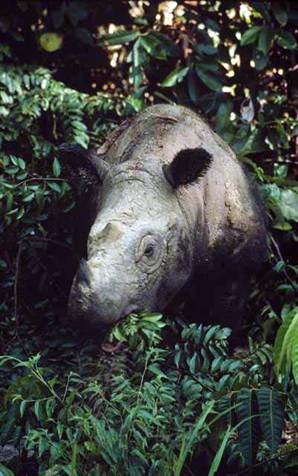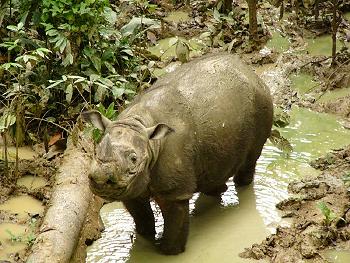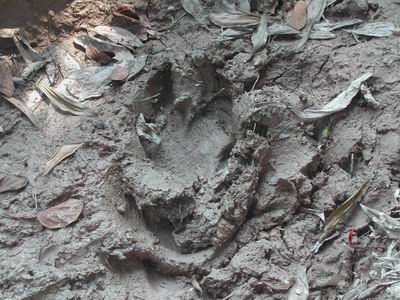
The Good News: Not extinct -- YET!
Portrait of the Sumatran Rhinoceros, Didermoceros sumatrensis.
Photo by Alain Compost (WWF-Canon).
For those of you who like to read about endangered species that have somehow managed to survive despite our best efforts to exterminate them, I have some good news! A small but apparently viable population of the Sumatran rhinoceros subspecies, Didermoceros sumatrensis harrissoni, is now confirmed to exist in the northeast state of Sabah on the island of Borneo.
 The Sumatran rhino is comprised of several subspecies that are thought to be extinct throughout their former range in the states of Sarawak (Malaysia) and Kalimantan (Indonesia) (map pictured). Even though none of these surviving rhinos have yet been seen, a search of the region in Sabah, known as "the Heart of Malaysia", during May 2005 revealed clearly distinguishable footprints from these diminutive rhinos, indicating that there is a group of at least 13 individuals residing in the area with several more individuals scattered throughout other parts of Sabah.
The Sumatran rhino is comprised of several subspecies that are thought to be extinct throughout their former range in the states of Sarawak (Malaysia) and Kalimantan (Indonesia) (map pictured). Even though none of these surviving rhinos have yet been seen, a search of the region in Sabah, known as "the Heart of Malaysia", during May 2005 revealed clearly distinguishable footprints from these diminutive rhinos, indicating that there is a group of at least 13 individuals residing in the area with several more individuals scattered throughout other parts of Sabah.
Rhinoceros have been the victims of widespread poaching because their horns are prized in many parts of the world because of their presumed medicinal powers. Due to public demand, rhino poaching is lucrative; their horns match the value of gold, ounce for ounce. In fact, the Sumatran rhino has already been driven to extinction in the nearly states of Kalimantan and Sarawak, but fortunately, this area of Sabah (so far) remains untouched by poaching.
"Poaching has decimated Borneo's once-healthy rhino population, but we were heartened to find that a few individuals have managed to cling to survival," said Raymond Alfred, of the Malaysian chapter of the international conservation organization World Wildlife Fund (WWF).
Previously, it was estimated that the population of Sumatran rhinos in Sabah was between 30 and 70, most of whom are widely separated by dense tropical forest, thereby making it difficult for them to breed. Because these newly discovered animals are clustered together, it appears that they form a viable breeding population.
"There is evidence that there are young animals in the group so it would appear that breeding is indeed taking place," said Christy Williams, head of the WWF's Asian rhino program. He said that this has sparked hopes that the population of Borneo Sumatran Rhino can again flourish, at least in Sabah.
"We believe this population may be viable and could recover if their habitat is protected and the threat of poaching is eliminated," added Williams.
The field surveys were conducted by 16 teams consisting of 120 government wildlife officials and academics from the Yayasan Sabah (Sabah Foundation), the Sabah Wildlife Department, Sabah Forestry Department, Sabah Parks, S.O.S. Rhino, Kinabatangan Orang-utan Conservation Project, Universiti Malaysia Sabah, Operation Raleigh and WWF-Malaysia. Team members hiked through heavy tropical rains in leech-infested jungles during their two-week expedition, Williams said.
The discovery was not made public until now to allow officials time to enact "strong protection measures" against poachers, according to the WWF statement. Additionally, logging will be phased out in large tracts of forests throughout the "Heart of Borneo", which includes the rhino's habitat, according Sabah's Chief Minister, Musa Aman.
 A critically endangered species, the Sumatran rhino (pictured, photo by Peter and Jackie Main) once ranged widely throughout southeast Asia, but poaching has reduced the population to fewer than 300 individuals in the wild.
A critically endangered species, the Sumatran rhino (pictured, photo by Peter and Jackie Main) once ranged widely throughout southeast Asia, but poaching has reduced the population to fewer than 300 individuals in the wild.
There are five extant rhino species. The island-dwelling Sumatran rhino is the smallest of these rhinos, standing only 4.5 feet tall and weighing one ton.
This species is also known as the hairy rhino because calves and young adults are clad in fuzzy reddish-brown hair, which is replaced by sparse blackish bristles in older animals. A descendant of the extinct woolly rhino, this species has remained unchanged for the last 2 million years. The Sumatran rhino is vegetarian, eating seedlings and young trees, and it only ventures out from the dense cover of forest under very unusual circumstances. Interestingly, this species has a voice that is similar to that of another endangered species, the humpbacked whale.
The Sumatran rhino is the only Asian rhino with two horns. Its front horn is generally less than 25 centimeters (10 inches) long, while the posterior horn is often just a small bump. The horn is comprised of a mass of hair that grows from the skin of the rhino's snout. In early times, the horn was made into drinking cups that were believed to detect poison, and in the Far East, especially in China, people believe that the horn reduces fever, despite the fact that scientific tests have shown that it has no medicinal effects whatsoever.
Currently, proven medicines are being promoted in Far Eastern countries to help reduce the demand for rhino horn. By reducing the demand for rhino horn, conservationists hope to drive its market value down so this will cause poachers to stop killing rhinos.
The forests of Sabah and the "Heart of Borneo" still have large tracts of natural rainforests, which are some of the most biologically diverse habitats on Earth. These forests are home to considerable numbers of unique animal and plant species. Other threatened wildlife in Borneo include clouded leopards, Neofelis nebulosa, sun bears, Helarctos malayanus, and three species of leaf monkeys found nowhere else in the world. The island is also home to 10 primate species, including the endangered Orang-Utan, Pongo pygmaeus, more than 350 species of birds, 150 reptiles and amphibians and 15,000 plants.
Thanks, Diane!

Footprint of the Sumatran Rhinoceros, Didermoceros sumatrensis.
Photo by Reza Azmi.
Source Material (links throughout piece);
BBC News, (map graphic).
Associated Press (quotes).
The Star (quotes).
Environmental News Service Photo.
WWF (details).
MongoBay News (details).
Photographer Reza Azmi (footprint photo).
- Log in to post comments



Lovely!
I've got a jaundiced view of my countrymen's green credentials, since the state governments turn a blind eye to a lot of illegal logging, but this seems genuine. The Sabah state government at least recognises the importance of wildlife - hopefully the protected area will turn into another Sepilok (http://www.sabah.edu.my/srm012.wcdd/BM/menu1.html)
Now if only they could do the same for the Malayan tiger...
Hurrah! There is hope for wildlife conservation in Southeast Asia!
I'm from Singapore, and it gets depressing to see the pressing wildlife conservation issues that get overlooked because of economic growth.
And I don't want to nitpick, but isn't the Sumatran rhinoceros supposed to be Dicerorhinus? And I don't think it's that easy to place it as a descendant of the woolly rhino; more like its closest living relative seems more likely.